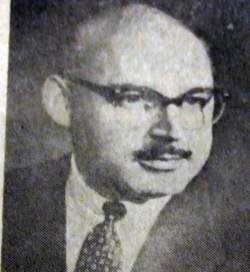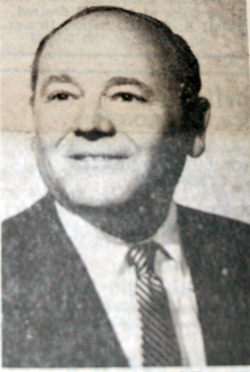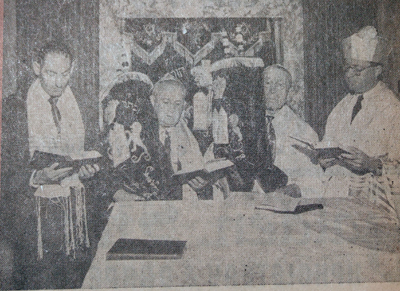Compiled by San Diego Jewish World staff
Hutler Says Israel Greatest Social Planning In World
Southwestern Jewish Press, September 21, 1956, Pages 1,3, 5
KIRIAT GAT, ISRAEL –Little more than a year ago this name did not exist. For the town which is so named was only a dream in the minds of Israel’s national planners. So swiftly do things happen around here that today Kiriat Gat is a flourishing town with a population approaching 3,000, a railway station and a big future.
Kiriat Gat is named after the ancient city of Gat which prospered a few miles from here in the days of the Philistines. “Tell it not in Gat, publish it not in the streets of Ascalon,” David said in his lament over the deaths of Saul and Jonathan four thousand years ago. But Kiriat Gat, though it has a link with the biblical past, is ultra-modern.
This town is the urban center of a new experiment which is daring in concept and its all-encompassing sweep but which is working. Kiriat Gat is the center of the Lachish regional development scheme, Israel’s first program of this nature.
The men who made the birth of Israel possible through three generations of pioneering efforts knew that regional planning made sense. But severe land restrictions, the fact that the power to govern was in other hands, and other handicaps prevented them from working with the sweeping strokes which regional planning requires. And, in the first years after the birth of Israel in 1948, the flood of problems was so great that there was no time, no leisure for bold experiments.
At last, a year and a half ago, the harassed officials of the Jewish Agency Agricultural Settlement Department, who had settled some 250,000 newcomers on the land since statehood, were able to take a whole district, study its needs and its potentialities and begin to build an integrated working unit, economically and humanly. This is what was attempted in Lachish and I have seen the results during a study tour with nine other Executive Directors of Community Camps affiliated with the nationwide United Jewish Appeal.
Before we left Jerusalem to begin our inspection trip in the Lachish district, we were told that this 175,000 acre area — huge for little Israel — had been virtually empty, neglected, eroded, sterile until the project was launched. That was hard to believe, for today the area is certainly bursting with life.
The big rectangle of land stretching from the Judean foothills almost to the Mediterranean is the new home of 1,340 families, over 5,500 people, most of them new immigrants from North Africa. In little over a year 27 agricultural settlements were established. Schools, nurseries and stores, synagogues and workshops have been set up. Electricity has been brought in, water pipelines have been laid, new roads have been built. The new work, all under the direction of the UJA-supported Jewish Agency, required the efforts of some two dozen different organizations, from a water company to a grocery chain.
We went to the village of Otzem, inhabited by sturdy people from the Atlas Mountains of Morocco. The progress there was clear and dramatic. These people had come direct from Haifa port via the Jewish Agency’s ship-to-settlement program, and they had moved into simple one-room wooden shacks. Then, with the aid of Otzem and most of the other Lachish villages, which have sprung up so quickly, the wooden shacks are still present — but they are used to store tools and seeds and the people live in neat, white-washed, red-roofed, 3-room concrete homes.
What is more, the people themselves are slowly changing. They came from an isolated and backward part of the world. But they are learning the principles of hygiene, they are learning to govern themselves through an elected village council, they are learning the language of the country — Hebrew — through daily practice and via night school.
The new farmers, many of whom had never tilled the soil before, are beginning to earn their own living on the land, but it is a lucky village which has more than one delivery truck and a couple of donkey-drawn carts. The Lachish planners, thinking always of the human problem, have done something about that problem. Every four villages are grouped around a fifth village, a service center. Here is situated the tractor station, a barber, a well-stocked store with seeds and farm implements as well as clothing and food, a youth center, a health center, and all the other services required by farmers. No village is more than 1 1/2 miles from the service center.
The economic element was borne in mind too. The farmers of Lachish have gone in for Israel’s newest crop, cotton, in a big way. And so the town of Kiriat Gat, Lachish’s capital, has a cotton gin. And so cotton grown in Lachish can be processed nearby and at a considerable saving in transport. Now a spinning mill is planned for Kiriat Gat.
The story of the gin is typical of what’s been going on in Lachish, typical of the amazing pace of building. The foundation and walls of the gin building went up in a few months. But that wasn’t fast enough for the farmers; their cotton was ready. And so the machinery was installed and put to work — before the roof was laid.
The men who are building Lachish, the expert planners of the Jewish agency, believe in Lachish. They have moved their offices and their homes to Kiriat Gat; they don’t have telephone service, but they do their work somehow.
Today they have finished the first stage of the Lachish plan — the erection of 27 settlements plus rural centers and a town center. Yet much remains to be done. It takes five to six constant injections of funds and expert advice and love to make a village self-supporting. The work has only begun.
Meanwhile, a second regional settlement scheme has been launched — in the Ta’anach region at the southern edge of the Emek Jezreel, the Valley of Esdraelon. And more are planned as Israel continues, despite the tense security situation, to struggle forward to the day of economic self-sufficiency.
*
“A Portrait of Hadassah” To Be Exhibited Sept. 26
Southwestern Jewish Press, September 21, 1956, Page 1
The San Diego Chapter of Hadassah will have the pleasure of presenting Mrs. Leo Hirsh at the premier Membership-luncheon on Wednesday, Sept. 26, at the El Cortez Hotel. Mrs. Hirsh, who has recently returned from Europe and Israel, is the president of the Pacific Coast Region of Hadassah, President of the San Fernando chapter of Hadassah and Chairman of greater Los Angeles Women’s Welfare Division.
Mrs. Sam Cohen, Chairman of the Luncheon and Membership, reports that every day brings additional new and exciting plans. The staging of Hafter’s Couturier Fashion Show will be arranged to augment the original creations of designers Rud Genreich, Wayne Fuller and Michael Anthony, who will commentate. “A Portrait of Hadassah” is the overall luncheon theme and will be highlighted by a surprising mirrored effect.
Mrs. Herbert Solomon, of the Mr. and Mrs. Hadassah evening group, has been accepting new members and invites anyone wishing to join to contact her.
All newly enrolled members will be guests of the chapter and reservations may be made with Mrs. Lawrence Weiss, AT-2-6539. Beginning with a Sherry hour at 11 o’clock, the entire afternoon will consist of entertaining ingredients insuring a memorable time for all.
*
Local Leader To Visit Israel On Study Mission
Southwestern Jewish Press, September 21, 1956, Page 1

The San Diego Jewish community has been singularly honored by action of the national United Jewish Appeal in inviting three of its top leaders to join a study mission of American Jewish leadership to Israel in October. Dr. Walter Ornstein, who has accepted, will travel to Israel as part of a select national group which will attend a conference of Joint Distribution Committee European directors and then visit Israel.
Travelling at their own expense they will confer with top government officials to discuss the economic situation facing Israel and the needs of the immigrants who are assisted in their integration with American Jewish community money. They will also tour the country, its factories, institutions and military bases then return to the United States to report back to the National Conference of American Jewish communities, which will be held late in November in preparation for the 1957 United Jewish Appeal.
Dr. Ornstein will remain in Israel for several weeks after the tour’s completion, at the invitation of the medical faculty of Hebrew University, in order to do some research at the medical school.
Dr. Ornstein, one of San Diego’s top Jewish leaders, is President of the Jewish Social Service Agency, Vice President of the united Jewish Fund, and was singularly honored at the Fund’s 1955 Annual Meeting by the United Hias Service for his work with newcomers to San Diego. He is also a member of the Nationla Board of United Hias Service and is a Director of the Community Welfare Council. Dr. Ornstein is also Vice-President of Beth Jacob Congregation.
Others invited were Mr. Harry Sugarman and Mr. Max Rabinoitz who were unable to go.
*
Nominating Committee Of Fund Seeks Names For Board
Southwestern Jewish Press, September 21, 1956, Page 1
 Suggestions for nominees for the Board of Directors for the United Jewish Fund are now being accepted by the Nominating Committee for its first meeting to be held on Wednesday, September 26, William Colt, Chairman, announced.
Suggestions for nominees for the Board of Directors for the United Jewish Fund are now being accepted by the Nominating Committee for its first meeting to be held on Wednesday, September 26, William Colt, Chairman, announced.
Stating that the Nominating Committee would welcome any suggestions of names to fill 20 vacancies for a two year term, 1967-58, Colt urged all members of the Fund to recommend individuals whom they feel would be eligible. Recommendations may be forwarded either to Mr. Colt, BE -3-6436, or to Albert A. Hutler, Executive Director, United Jewish Fund. “In this way,” Colt said, “it is hoped that many suggestions will come from the community at large to the Nominating Committee.”
However, in his statement Mr. Colt warned that only members of the Fund are eligible to serve on its Board. Defined by the by-laws, a member is a contributor to the United Jewish Fund whose pledge for the year preceding the current year is paid in full.
Colt also pointed out that any five members of the United Jewish Fund may nominate any other member of the Fund they so desire by petitioning to have their name placed on the ballot at the Annual Meeting. Such petitions must be in the hands of the Secretary, Seymour Rabin, or the Executive Director, on or before five days before the date of the Annual Meeting.
*
San Diego Woman Receives Honors
Southwestern Jewish Press, September 21, 1956, Page 1
Besides her job as a member of the Executive Committee of the Women’s Division of the National United Jewish Appeal, Mrs. Gabriel Berg has just received three additional honors.
A former Women’s Division Campaign Chairman and a Director of the United Jewish Fund, Mrs. Berg has been notified of her appointment to the new National Women’s Committee Executive Board of the Council of Jewish Federations and Welfare Funds, which has been organized to stimulate women’s participation in the American Jewish community.
One of 15 women throughout the country given this honor, Mrs. Berg is also a member of the executive committee of the West Coast Office of Hadassah in charge of membership, and the Expansion Chairman for the Southern Pacific Coast Region of Hadassah.
*
Community Mourns Passing of Paul Nestor
Southwestern Jewish Press, September 21, 1956, Page 1
Paul Nestor, aged 65 years, a resident of San Diego for 45 years, passed away on September 4. Services were held on Wednesday, Sept. 5, at the Tifereth Israel Synagogue. Rabbi Monroe Levnes officiated, assisted by Cantor Joseph Cysner. Lewis Colonial Mortuary was in charge of funeral arrangements. Entombment in Sholem Mausoleum.
Survivors are his wife, Freda, a son, Burton, a daughter Syril Press, three grandchildren, two brothers Jank Kanister of San Pedro and Max Knaster of New York, and a sister Mrs. Belle Hoffman of New York.
Mr. Nestor was a member of the S.D. Lodge No. 35, F. & A. M., Eagles Lodge, American Legikon Post No. 6, Jewishu War Veterans, Sameul I. Fox, B’nai B’rith, Past Pres of Lasker Lodge B’nai B’rith, on the Board of Directors at Tifereth Israel Synagogue, and very active in the Hebrews Home for the Aged.
*
Hebrew Home Has High Holy Day Services For Guests
Southwestern Jewish Press, September 21, 1956, Page 1

Cantor Arie Horowitz, right, leads Rosh Hashana services at the San Diego Hebrew Home for the Aged, 4075 54th St. Others, from left, are Charles Frankel, Leo Landshut and J.A. Levinson, bearing Jewish holy scrolls, who assisted with the High Holy Days at the Home.
*
Adventures in San Diego Jewish History” is sponsored by Inland Industries Group LP in memory of long-time San Diego Jewish community leader Marie (Mrs. Gabriel) Berg. Our “Adventures in San Diego Jewish History” series will be a regular feature until we run out of history. To find stories on specific individuals or organizations, type their names in our search box, located just above the masthead on the right hand side of the screen.